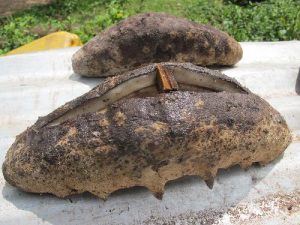Patterns of serial exploitation of sea cucumbers in the Great Barrier Reef Marine Park
By Jake Jerome, RJD Graduate Student and Intern
There is no doubt that overfishing is a major threat to ocean ecosystems. When most people think of overfishing, they think of the over harvesting of fish species that many in the world rely on. However, there are species besides fish that face the threat of exploitation. Eriksson and Byrne found in 2013 that the tropical sea cucumber fishery in Australia’s Great Barrier Reef Marine Park (GBRMP) is following patterns of overexploitation.
To reach this conclusion, the authors performed a meta-analysis of catches in the fishery from 1991 to 2011 by reviewing data published in peer reviewed literature and fisheries reports. From their analysis they found that the sea cucumber fishery initially focused only on harvesting high-valued species but shifted towards lower-valued species over time. The initial target was black teatfish (Holothuria whitmaei) until 1999, when a 70% decline in the catch of black teatfish was noted, and subsequent effort then shifted towards the white teatfish (H. fuscogilva). The fishery was subsequently diversified after the collapse of the black teatfish to include other species of medium and low-value. Despite the addition of these new species into fishery efforts in 1999, most of them no longer appeared on catch lists as of 2005. Two new key target species prompted an increase in the harvest during the 2004 to 2011 period, though they were species of lower value than the teatfish.

Catch records from the Queensland East Coast bêche-de-mer fishery (ECBDMF). The three areas indicated in the figure are conceptual periods in the fishery based on the composition of catch. (Eriksson and Byrne 2013)
A major problem with the sea cucumber fishery in the GBRMP is the lack of information about the original population sizes of the species targeted. Without a baseline of knowledge, predicting the critical threshold beyond which a species can no longer recovery is extremely difficult. Because of this, many of these species may have been fished past their critical threshold and may not be able to avoid extinction.
With Australia being a developed high-income country, it is expected that management of fisheries is better resourced then it would be in low developed countries. This study showed that serial expansion and the quick replacement of high-valued species with lesser valued individuals is not limited to fishing practices in low-income developing countries and is a common trend in the overexploited global sea cucumber fishery. This is important to the fishery because it points out gaps in the management of sea cucumbers. Although Australia tried to manage this particular fishery with a rotational zoning scheme (RZS) in 2004, it proved to be either too late or ineffective. In addition, this study illustrates that providing relatively few fishermen access to a large fishing area through licensing, does not necessarily transfer to sustainable sea cucumber harvest.
In the end, it is clear that more studies need to be done on population sizes of tropical sea cucumbers to accurately assess their vulnerability. Without being able to monitor populations as they are harvested, effectively managing the many now threatened or endangered sea cucumbers will continue to be a problem.
Reference
Eriksson, H. and Byrne, M. (2013), The sea cucumber fishery in Australia’s Great Barrier Reef Marine Park follows global patterns of serial exploitation. Fish and Fisheries. doi: 10.1111/faf.12059

